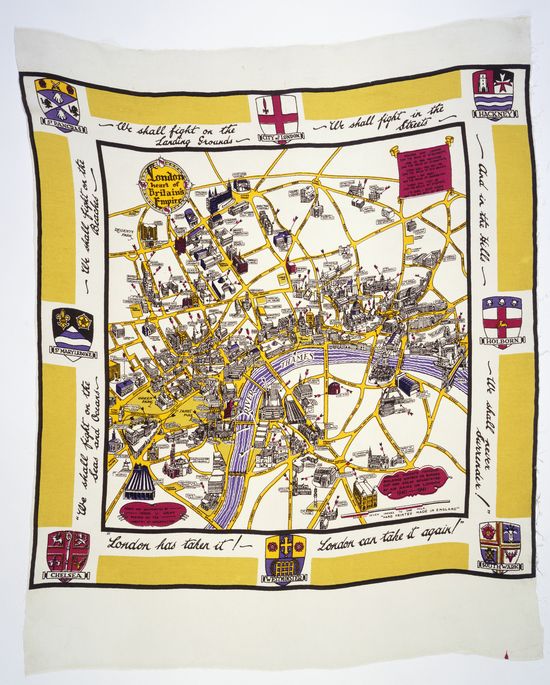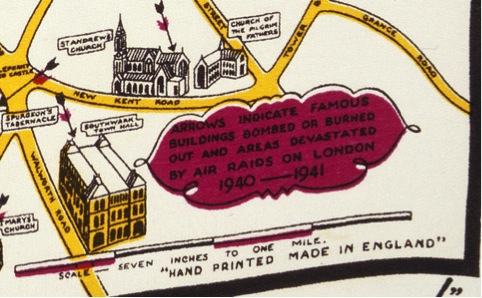In the wake of the fire at Southwark's Cuming Museum and Newington Library, Robert Davies, Social Sciences Engagement Officer, explores local history resources for Walworth and Southwark
“Forward then, but still remember how the course of Time will swerve,
Crook and turn upon itself in
many a backward streaming curve”
(From ‘Locksley Hall – Sixty Year’s after’ by Alfred, Lord
Tennyson)
When I toured our ‘Propaganda: Power and Persuasion’
exhibition recently I was rather surprised by the strength of my reaction to
one of the exhibits; namely the ‘London has taken it! London can take it
again! headscarf, c.1942’ which was designed and printed by Nicol
V.Gray as a limited edition of ten scarves.

Loan and Image courtesy of the Museum of London (MoL
reference LW.COS.U.B21.D1.10.)
The scarf shows a map of London with the legend “arrows
indicate famous buildings bombed or burned out and areas devastated by air
raids 1940-41". The map is surrounded by borders quoting Churchill’s ‘We
Shall Fight Them on the Beaches, We shall fight on the Seas and Oceans, we shall fight on the landing grounds, we shall
fight in the streets and in the hills and we shall never surrender!’ speech and
American broadcaster Ed Murrow’s famous exultation ‘London can take it!’
However, my emotional reaction was not in response to the
quotes themselves, but triggered by the conjunction of text and images found
towards the bottom left corner of the scarf:

Loan and Image courtesy of the Museum of London (MoL reference LW.COS.U.B21.D1.10.)
The comment which immediately came to mind was one made to me
on the 26th March 2013 by a neighbour whilst we were standing surveying the damage
caused to the town hall by the fire which had occurred the day before: ‘‘that
building survived the blitz, now look at it”.
Part of the roof of the town
hall, built between 1864-5 and extended c.1900, can be glimpsed in the
bottom left hand corner of the photograph below which was taken during the fire
of the 25th. The building houses council
offices and services and the Cuming
Museum and forms part of a complex
of civic buildings including the Newington
Library (the building wreathed in smoke in the mid-ground of the image
below) and the ‘Walworth
Clinic’ building (not visible in the photograph) which was completed in
1937 and with its plaque above the door which states ‘the health of the people is the highest law’.
 Image reproduced with the kind permission of www.tomleighton.co.uk (Further images of the fire and the resultant damage can
be found by using the search term Cuming Museum Fire)
Image reproduced with the kind permission of www.tomleighton.co.uk (Further images of the fire and the resultant damage can
be found by using the search term Cuming Museum Fire)
A set of buildings, services and museum and library collections,
and recent circumstances, which perhaps evoke many different memories and
thoughts: from having lived through the
blitz and witnessing the changes wrought on the area by bombing and the associated
re-developments over the following decades; the continuities of particular
places, sites and activities; the development of ‘integrated’ health care
systems which prefigured the formation of the NHS; getting married or, in my
case, getting to learn about the history of the Cuming Family Collections, the
history of SE17 and the Borough of Southwark more generally after moving to
London.
All of this has prompted me to explore some of the resources
the British Library might hold not only in relation to the history of the area
but also how we perhaps develop and maintain a sense of place and belonging. As always the starting point was searching
the main catalogue.
Searching for ‘Walworth’ - not including Walworth Castle,
County Durham (near where I spent part of my childhood) and Walworth County,
Wisconsin - alone retrieved 22 Oral Histories recorded under a wide variety of
projects including the Millennium Memory Bank; Food: From Source to Salespoint;
the Methodist Church Oral Archive; Labour Oral History Project; Oral History of
the Post Office; Lives in the Oil Industry and Oral History of British
Photography; plus many articles, books, maps and journals.
I’ve discovered a plethora of books, journals and articles
relating to the study and research of the formation and maintenance of a sense (or
senses) of belonging and identity in an era or globalisation. The bibliography below provides only a small
selection of such works, so I am off to call up more volumes from the stacks
and, on a slightly different note, book an appointment to see a chiropodist at
the Walworth Clinic.
It almost goes without saying that I look forward to the
re-opening of the Cuming Museum and Newington Library in the not too distant
future.
Bibliography
Appadurai, A. The Production of Locality (in Counterworks,
Managing the diversity of Knowledge). Shelfmark 6963.140000
Baxter, M. / Lock, D.
Walworth through time (2011
reprint) Shelfmark YK.2011.a.33958
Boast, M. The Story of Walworth, (revised edition,
1993) Shelfmark YK 1993.a.10636
Humphrey, S. An introduction to the Cuming Family and the
Cuming Musem (2002) Shelfmark
YC.2003.b.966
Huyssen, A. Present
Pasts: Urban Palimpsests and the Politics of Memory (2003) Shelfmark
M03/18743
Krapp, P. Deja Vu: Aberrations of Cultural Memory(2004)
Shelfmark YC.2006.a.2010
Najafi, F. / Mustafa Kamal Bin Mohd Shariff The Concept of Place and Sense of Place in
Architectural Studies, International Journal of Human and Social Sciences
6.3.2011
Rogagly, B. / Taylor, B. Moving
Histories of Class and Community – Identity Place and Belonging in Contemporary
England, Identity Studies in the Social Sciences(2009) Shelfmark YC.2012.a.6736
Said, Edward W. Invention,
Memory and Place (in Critical Inquiry 26, Winter 2000) available via JSTOR
Savage, M./ Bagnall, G./ Longhurst, B. Globalization and Belonging(2005) Shelfmark YC.2009.a.10770
Links to external resources:
Southwark Local History Library: http://www.southwark.gov.uk/info/200161/local_history_library
BBC WW2 Peoples War: http://www.bbc.co.uk/history/ww2peopleswar/
Bomb Sight: Mapping the WW2 Bomb Census http://www.bombsight.org/#15/51.4881/-0.1222
Robert Davies can be found on twitter @blrobertdavies